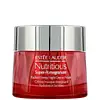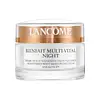What's inside
What's inside
 Key Ingredients
Key Ingredients

 Benefits
Benefits

 Concerns
Concerns

 Ingredients Side-by-side
Ingredients Side-by-side

Water
Skin ConditioningDimethicone
EmollientIsohexadecane
EmollientGlycerin
HumectantBis-PEG-18 Methyl Ether Dimethyl Silane
EmollientButylene Glycol
HumectantPEG-10 Dimethicone
Skin ConditioningPropanediol
SolventPetrolatum
EmollientDisteardimonium Hectorite
StabilisingSucrose
HumectantHypnea Musciformis Extract
Skin ProtectingVaccinium Angustifolium Fruit Extract
Skin ProtectingPaeonia Suffruticosa Root Extract
Skin ProtectingSapindus Mukorossi Fruit Extract
Skin ConditioningCladosiphon Okamuranus Extract
Skin ConditioningCucumis Sativus Fruit Extract
EmollientHordeum Vulgare Extract
EmollientVaccinium Macrocarpon Fruit Extract
AstringentLycium Chinense Fruit Extract
AntioxidantGelidiella Acerosa Extract
Skin ProtectingGlycine Soja Seed Extract
Skin ConditioningIsododecane
EmollientAcetyl Glucosamine
Skin ConditioningSorbitol
HumectantTocopheryl Acetate
AntioxidantPunica Granatum Extract
AstringentCaffeine
Skin ConditioningErgothioneine
AntioxidantYeast Extract
Skin ConditioningPropylene Glycol Dicaprate
EmollientSodium Hyaluronate
HumectantHelianthus Annuus Seedcake
AbrasivePolysilicone-11
Caesalpinia Spinosa Gum
Skin ConditioningCaprylyl Glycol
EmollientPropylene Carbonate
SolventPolyethylene
AbrasiveTetrahexyldecyl Ascorbate
AntioxidantDextrin
AbsorbentCitric Acid
BufferingPEG-32
HumectantPEG-6
HumectantParfum
MaskingHexylene Glycol
EmulsifyingSodium Citrate
BufferingDisodium EDTA
BHT
AntioxidantCitral
PerfumingPhenoxyethanol
PreservativeIron Oxides
Water, Dimethicone, Isohexadecane, Glycerin, Bis-PEG-18 Methyl Ether Dimethyl Silane, Butylene Glycol, PEG-10 Dimethicone, Propanediol, Petrolatum, Disteardimonium Hectorite, Sucrose, Hypnea Musciformis Extract, Vaccinium Angustifolium Fruit Extract, Paeonia Suffruticosa Root Extract, Sapindus Mukorossi Fruit Extract, Cladosiphon Okamuranus Extract, Cucumis Sativus Fruit Extract, Hordeum Vulgare Extract, Vaccinium Macrocarpon Fruit Extract, Lycium Chinense Fruit Extract, Gelidiella Acerosa Extract, Glycine Soja Seed Extract, Isododecane, Acetyl Glucosamine, Sorbitol, Tocopheryl Acetate, Punica Granatum Extract, Caffeine, Ergothioneine, Yeast Extract, Propylene Glycol Dicaprate, Sodium Hyaluronate, Helianthus Annuus Seedcake, Polysilicone-11, Caesalpinia Spinosa Gum, Caprylyl Glycol, Propylene Carbonate, Polyethylene, Tetrahexyldecyl Ascorbate, Dextrin, Citric Acid, PEG-32, PEG-6, Parfum, Hexylene Glycol, Sodium Citrate, Disodium EDTA, BHT, Citral, Phenoxyethanol, Iron Oxides
Water
Skin ConditioningDimethicone
EmollientHydrogenated Polyisobutene
EmollientParaffinum Liquidum
EmollientGlycerin
HumectantCetyl Alcohol
EmollientButylene Glycol
HumectantPEG-100 Stearate
Glyceryl Stearate
EmollientOryza Sativa Bran Oil
EmollientZea Mays Oil
EmulsifyingHydroxyethylpiperazine Ethane Sulfonic Acid
BufferingCI 15985
Cosmetic ColorantCI 19140
Cosmetic ColorantC13-14 Isoparaffin
EmollientTocopheryl Acetate
AntioxidantTocopherol
AntioxidantAscorbyl Glucoside
AntioxidantHydroxycitronellal
PerfumingPhenoxyethanol
PreservativeMagnesium Aspartate
Skin ConditioningTriticum Vulgare Germ Oil
EmollientPolyacrylamide
Chlorhexidine Digluconate
AntimicrobialPolycaprolactone
StabilisingPanthenol
Skin ConditioningPentaerythrityl Tetra-Di-T-Butyl Hydroxyhydrocinnamate
AntioxidantBenzyl Salicylate
PerfumingBenzyl Alcohol
PerfumingLinalool
PerfumingZinc Gluconate
Skin ConditioningCaprylyl Glycol
EmollientAlpha-Isomethyl Ionone
PerfumingCopper Gluconate
Skin ConditioningSorbitan Tristearate
EmulsifyingCera Microcristallina
Emulsion StabilisingParaffin
PerfumingSesamum Indicum Seed Oil
EmollientRetinyl Palmitate
Skin ConditioningButylphenyl Methylpropional
PerfumingLaureth-7
EmulsifyingHexyl Cinnamal
PerfumingGlycine Soja Oil
EmollientParfum
MaskingWater, Dimethicone, Hydrogenated Polyisobutene, Paraffinum Liquidum, Glycerin, Cetyl Alcohol, Butylene Glycol, PEG-100 Stearate, Glyceryl Stearate, Oryza Sativa Bran Oil, Zea Mays Oil, Hydroxyethylpiperazine Ethane Sulfonic Acid, CI 15985, CI 19140, C13-14 Isoparaffin, Tocopheryl Acetate, Tocopherol, Ascorbyl Glucoside, Hydroxycitronellal, Phenoxyethanol, Magnesium Aspartate, Triticum Vulgare Germ Oil, Polyacrylamide, Chlorhexidine Digluconate, Polycaprolactone, Panthenol, Pentaerythrityl Tetra-Di-T-Butyl Hydroxyhydrocinnamate, Benzyl Salicylate, Benzyl Alcohol, Linalool, Zinc Gluconate, Caprylyl Glycol, Alpha-Isomethyl Ionone, Copper Gluconate, Sorbitan Tristearate, Cera Microcristallina, Paraffin, Sesamum Indicum Seed Oil, Retinyl Palmitate, Butylphenyl Methylpropional, Laureth-7, Hexyl Cinnamal, Glycine Soja Oil, Parfum
Ingredients Explained
These ingredients are found in both products.
Ingredients higher up in an ingredient list are typically present in a larger amount.
Butylene Glycol (or BG) is used within cosmetic products for a few different reasons:
Overall, Butylene Glycol is a safe and well-rounded ingredient that works well with other ingredients.
Though this ingredient works well with most skin types, some people with sensitive skin may experience a reaction such as allergic rashes, closed comedones, or itchiness.
Learn more about Butylene GlycolCaprylyl Glycol is a humectant and emollient, meaning it attracts and preserves moisture.
It is a common ingredient in many products, especially those designed to hydrate skin. The primary benefits are retaining moisture, skin softening, and promoting a healthy skin barrier.
Though Caprylyl Glycol is an alcohol derived from fatty acids, it is not the kind that can dry out skin.
This ingredient is also used as a preservative to extend the life of products. It has slight antimicrobial properties.
Learn more about Caprylyl GlycolDimethicone is a type of synthetic silicone created from natural materials such as quartz.
What it does:
Dimethicone comes in different viscosities:
Depending on the viscosity, dimethicone has different properties.
Ingredients lists don't always show which type is used, so we recommend reaching out to the brand if you have questions about the viscosity.
This ingredient is unlikely to cause irritation because it does not get absorbed into skin. However, people with silicone allergies should be careful about using this ingredient.
Note: Dimethicone may contribute to pilling. This is because it is not oil or water soluble, so pilling may occur when layered with products. When mixed with heavy oils in a formula, the outcome is also quite greasy.
Learn more about DimethiconeGlycerin is already naturally found in your skin. It helps moisturize and protect your skin.
A study from 2016 found glycerin to be more effective as a humectant than AHAs and hyaluronic acid.
As a humectant, it helps the skin stay hydrated by pulling moisture to your skin. The low molecular weight of glycerin allows it to pull moisture into the deeper layers of your skin.
Hydrated skin improves your skin barrier; Your skin barrier helps protect against irritants and bacteria.
Glycerin has also been found to have antimicrobial and antiviral properties. Due to these properties, glycerin is often used in wound and burn treatments.
In cosmetics, glycerin is usually derived from plants such as soybean or palm. However, it can also be sourced from animals, such as tallow or animal fat.
This ingredient is organic, colorless, odorless, and non-toxic.
Glycerin is the name for this ingredient in American English. British English uses Glycerol/Glycerine.
Learn more about GlycerinParfum is a catch-all term for an ingredient or more that is used to give a scent to products.
Also called "fragrance", this ingredient can be a blend of hundreds of chemicals or plant oils. This means every product with "fragrance" or "parfum" in the ingredients list is a different mixture.
For instance, Habanolide is a proprietary trade name for a specific aroma chemical. When used as a fragrance ingredient in cosmetics, most aroma chemicals fall under the broad labeling category of “FRAGRANCE” or “PARFUM” according to EU and US regulations.
The term 'parfum' or 'fragrance' is not regulated in many countries. In many cases, it is up to the brand to define this term.
For instance, many brands choose to label themselves as "fragrance-free" because they are not using synthetic fragrances. However, their products may still contain ingredients such as essential oils that are considered a fragrance by INCI standards.
One example is Calendula flower extract. Calendula is an essential oil that still imparts a scent or 'fragrance'.
Depending on the blend, the ingredients in the mixture can cause allergies and sensitivities on the skin. Some ingredients that are known EU allergens include linalool and citronellol.
Parfum can also be used to mask or cover an unpleasant scent.
The bottom line is: not all fragrances/parfum/ingredients are created equally. If you are worried about fragrances, we recommend taking a closer look at an ingredient. And of course, we always recommend speaking with a professional.
Learn more about ParfumPhenoxyethanol is a preservative that has germicide, antimicrobial, and aromatic properties. Studies show that phenoxyethanol can prevent microbial growth. By itself, it has a scent that is similar to that of a rose.
It's often used in formulations along with Caprylyl Glycol to preserve the shelf life of products.
Tocopheryl Acetate is AKA Vitamin E. It is an antioxidant and protects your skin from free radicals. Free radicals damage the skin by breaking down collagen.
One study found using Tocopheryl Acetate with Vitamin C decreased the number of sunburned cells.
Tocopheryl Acetate is commonly found in both skincare and dietary supplements.
Learn more about Tocopheryl AcetateWater. It's the most common cosmetic ingredient of all. You'll usually see it at the top of ingredient lists, meaning that it makes up the largest part of the product.
So why is it so popular? Water most often acts as a solvent - this means that it helps dissolve other ingredients into the formulation.
You'll also recognize water as that liquid we all need to stay alive. If you see this, drink a glass of water. Stay hydrated!
Learn more about Water